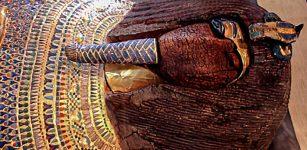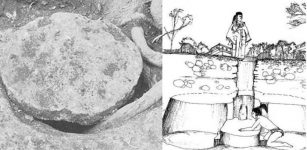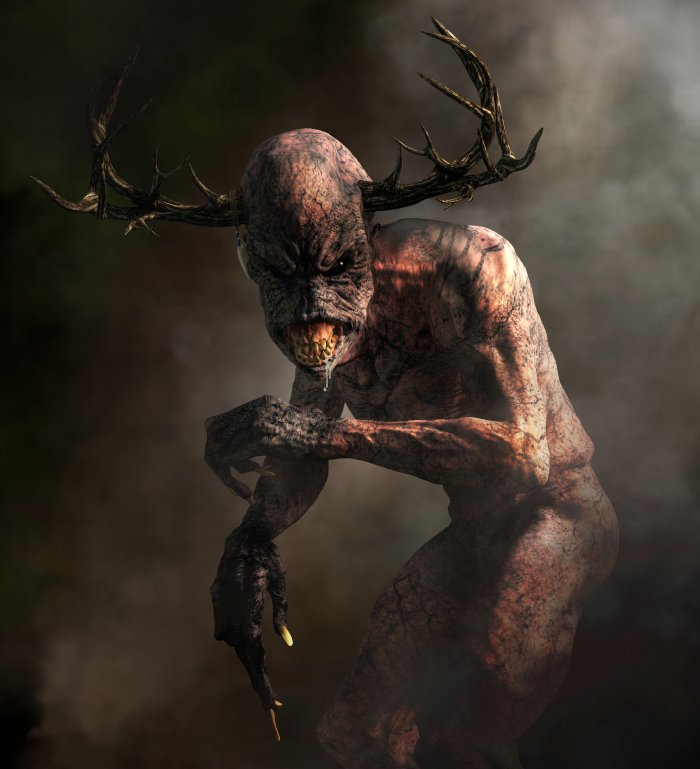Wendigo: Cannibalistic Shapeshifter In Mythology Of Indians Of North America And Canada
A. Sutherland - AncientPages.com - In some myths of the Algonquian tribes of North America, there is a mythical creature or spirit – Wendigo - that takes different forms.
A malevolent, cannibalistic, supernatural being - Wendigo. Credit: Adobe Stock - Daniel
It is a cannibal spirit and a monster that is always hungry. Its scream paralyzes its victims, so they're unable to escape. Wendigo (also known as Windigo, Weendigo, or Windago) is so horrific that many victims die of fright just looking at them.
They are the lucky ones. Those who remain alive are eaten alive, slowly. When Wendigo has nothing left to eat, it starves to death. When it sees something, it wants to own it. No one else can have anything. This illness feeds on a spiritual void.
The Wendigo is a danger that surrounds us. It is not only a creature from myths and legends of the ancients.
"There are two kinds of Windigo, although they are interrelated: spirit Wendigos and human Windigos. The name "Wendigo" derives from an Algonquian root word meaning "evil spirit" and "cannibal." Jesuit missionaries reported sightings of Wendigos in the 1600s. The Wendigo is an incredibly tall, gaunt spirit of harsh winter, frost, and starvation. Wendigos are spirits of ice, snow, and winter. Their hearts are made of ice. Sometimes, they travel in packs. They allegedly like to play catch or kickball with human skulls." 1
The Algonquian Native Americans represent the most extensive and numerous North American groups, with hundreds of tribes speaking several dialects related to the language group, Algonkian. The rich mythology of these people who lived in most of the Canadian territory below the Hudson Bay and between the Atlantic Ocean and the Rocky Mountains - survived many generations, and so did the Wendigo, a monster and bogeyman.
However, his abilities and evil doings vary depending on where the legends were gathered. Indeed, this monster spirit is not within the human, nor does the spirit manipulate the person. Instead, the human takes on the Wendigo's characteristics and behaves exactly like one. It means such a victim prey on other people, consuming them. It is a kind of infection that usually is acquired voluntarily (through rituals) or not.
The Wendigo has the power to possess a human being, and so it can alter its victim to become a cannibal.
Not only cannibalism is associated with the Wendigo but also with murder and voracious greed, and this kind of behavior has always been condemned in these indigenous communities. Some people would even wish to become Wendigos to have the power, perhaps to protect against enemies or punish others.
In some myths and legends of the Algonquin-speaking peoples, those who commit sins such as selfishness, greed, or cannibalism are turned into a Wendigo - as punishment.
Among the peoples of Canada, around Berens Lake, located in Manitoba, along the eastern shore of Lake Winnipeg, the Wendigo is an amphibious being like an alligator with bear's feet or cloven hooves.
The creatures are described as "exceptionally tall but gaunt and emaciated. They usually lack clothing, no matter how far below zero the temperature. The Windigo may be sensed before it is seen or heard: those close often feel chills. Sometimes, their arrival is accompanied by blizzards. Human Windigos do not achieve the immense height of their spirit counterparts." 1
In the beliefs of the Chippewa Indians, also known as the Ojibwe, this evil creature is an ogre focused on children to obtain their compliant behavior. Along with other indigenous tribes such as Eastern Cree, Westmain Swampy Cree, Naskapi, and Innu, the Ojibwe describe the Wendigo as a giant, many times larger than human beings.
In Algonquian folklore, however, the Wendigo is a dangerous, cannibalistic being - the spirit of a lost hunter who now mercilessly preys upon humans. They say that it roams about forests, devouring unfortunate human beings.
The Wendigo is never happy; he is never satisfied with his killings and consuming of the bodies; he is constantly searching for new victims. His hunger is limitless.
Written by A. Sutherland - AncientPages.com Staff Writer
Updated on February 19, 2024
Copyright © AncientPages.com All rights reserved. This material may not be published, broadcast, rewritten or redistributed in whole or part without the express written permission of AncientPages.com
Expand for referencesMore From Ancient Pages
-
 Why Did Vikings Hide A Precious Silver Treasure Under The Thralls’ House?
Archaeology | Sep 18, 2024
Why Did Vikings Hide A Precious Silver Treasure Under The Thralls’ House?
Archaeology | Sep 18, 2024 -
 Rare Ancient Precious Artifacts Found In Rusovce, Slovakia
Artifacts | Sep 26, 2015
Rare Ancient Precious Artifacts Found In Rusovce, Slovakia
Artifacts | Sep 26, 2015 -
 Great Wall Of Gorgan: One Of The World’s Most Sophisticated Frontier Walls Ever Built Is Now Examined
Archaeology | Dec 26, 2017
Great Wall Of Gorgan: One Of The World’s Most Sophisticated Frontier Walls Ever Built Is Now Examined
Archaeology | Dec 26, 2017 -
 Oldest Olive Oil Press Facilities Owned By Mysterious Woman ‘Arete’ Unearthed In Antalya, Turkey
Archaeology | Apr 2, 2017
Oldest Olive Oil Press Facilities Owned By Mysterious Woman ‘Arete’ Unearthed In Antalya, Turkey
Archaeology | Apr 2, 2017 -
 Long-Lost Paleontological Site With More Than 100 Unique Fossils Re-Discovered In Brazil
Archaeology | Jul 4, 2022
Long-Lost Paleontological Site With More Than 100 Unique Fossils Re-Discovered In Brazil
Archaeology | Jul 4, 2022 -
 Manx: Ancient Dead Gaelic Language That Refused To Die And Has Been Revived Again
Ancient History Facts | Oct 7, 2016
Manx: Ancient Dead Gaelic Language That Refused To Die And Has Been Revived Again
Ancient History Facts | Oct 7, 2016 -
 Dispute And Mystery: Strange Case Of The Tomb KV55 In The Valley Of Kings, Egypt
Civilizations | Oct 8, 2015
Dispute And Mystery: Strange Case Of The Tomb KV55 In The Valley Of Kings, Egypt
Civilizations | Oct 8, 2015 -
 DNA Study Reveals How Europe’s Hunter-Gatherers Adapted To A New Way Of Life – Farming
Archaeology | Nov 24, 2015
DNA Study Reveals How Europe’s Hunter-Gatherers Adapted To A New Way Of Life – Farming
Archaeology | Nov 24, 2015 -
 Hatra: Ancient Powerful Caravan City That Could Withstand Invading Roman Armies
Featured Stories | Dec 12, 2020
Hatra: Ancient Powerful Caravan City That Could Withstand Invading Roman Armies
Featured Stories | Dec 12, 2020 -
 Massive Well-Preserved Second Temple-Era Aqueduct Unearthed In Jerusalem
Archaeology | Aug 29, 2023
Massive Well-Preserved Second Temple-Era Aqueduct Unearthed In Jerusalem
Archaeology | Aug 29, 2023 -
 ‘Viking Disease’ Hand Disorder May Come From Neanderthal Genes
Archaeology | Jun 14, 2023
‘Viking Disease’ Hand Disorder May Come From Neanderthal Genes
Archaeology | Jun 14, 2023 -
 Did The Amazons Really Exist? – Truth Behind Myths Of Fierce Female Warriors
Featured Stories | Oct 29, 2014
Did The Amazons Really Exist? – Truth Behind Myths Of Fierce Female Warriors
Featured Stories | Oct 29, 2014 -
 8,000 Year-Old Human Skeleton Discovered By Cave Divers Near Tulum, Mexico
Archaeology | Sep 15, 2022
8,000 Year-Old Human Skeleton Discovered By Cave Divers Near Tulum, Mexico
Archaeology | Sep 15, 2022 -
 This Ancient Roman Painting Survived Eruption Of Mount Vesuvius In 79 A.D.
Archaeology | Aug 21, 2017
This Ancient Roman Painting Survived Eruption Of Mount Vesuvius In 79 A.D.
Archaeology | Aug 21, 2017 -
 Controversial Tunnel Plan Near Stonehenge Gets U.K. Government Approval – Shocked And Angry Opponents Will Challenge The Decision In High Court
News | Nov 13, 2020
Controversial Tunnel Plan Near Stonehenge Gets U.K. Government Approval – Shocked And Angry Opponents Will Challenge The Decision In High Court
News | Nov 13, 2020 -
 1,200-Year-Old Human Skeleton With A Jade Ring Unearthed In El Tigre Archaeological Zone
Archaeology | Aug 15, 2023
1,200-Year-Old Human Skeleton With A Jade Ring Unearthed In El Tigre Archaeological Zone
Archaeology | Aug 15, 2023 -
 Seven New Ancient Buddhist Caves – One With ‘A Harmika’ – Discovered In Mumbai
News | Jan 19, 2016
Seven New Ancient Buddhist Caves – One With ‘A Harmika’ – Discovered In Mumbai
News | Jan 19, 2016 -
 Rio Tinto Bosses Quit Over Destruction Of One Of The Earliest Aboriginal Sites
News | Sep 12, 2020
Rio Tinto Bosses Quit Over Destruction Of One Of The Earliest Aboriginal Sites
News | Sep 12, 2020 -
 Mysterious Chultuns – Ancient Underground Chambers Built By The Maya – But For What Purpose?
Featured Stories | Jun 24, 2017
Mysterious Chultuns – Ancient Underground Chambers Built By The Maya – But For What Purpose?
Featured Stories | Jun 24, 2017 -
 Unique And Unusually Large 8000-Year-Old Building Discovered At Çatalhöyük Site, Turkey
Archaeology | Sep 26, 2022
Unique And Unusually Large 8000-Year-Old Building Discovered At Çatalhöyük Site, Turkey
Archaeology | Sep 26, 2022

